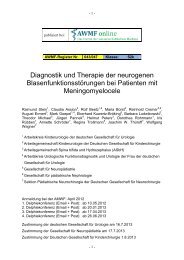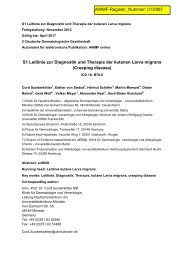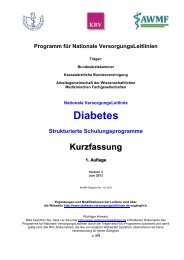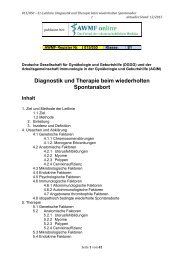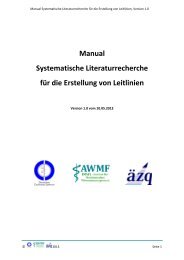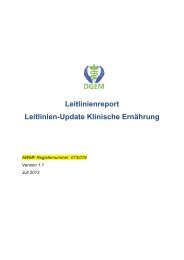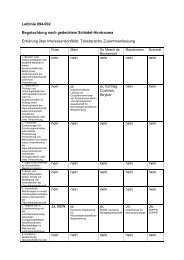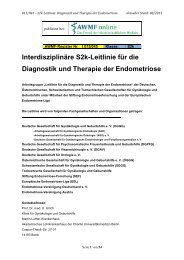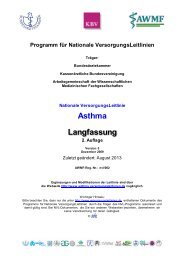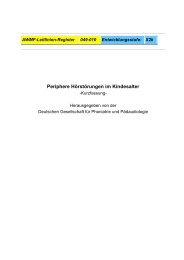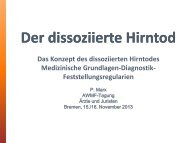Diagnose und Therapie der Bienen- und Wespengiftallergie - AWMF
Diagnose und Therapie der Bienen- und Wespengiftallergie - AWMF
Diagnose und Therapie der Bienen- und Wespengiftallergie - AWMF
Erfolgreiche ePaper selbst erstellen
Machen Sie aus Ihren PDF Publikationen ein blätterbares Flipbook mit unserer einzigartigen Google optimierten e-Paper Software.
108. Ruëff F, Przybilla B, Bilò MB, Müller U, Scheipl F,<br />
Aberer W, Birnbaum J, Bodzenta-Lukaszyk A, Bonifazi F,<br />
Bucher C, Campi P, Darsow U, Egger C, Haeberli G,<br />
Hawranek T, Körner M, Kucharewicz I, Küchenhoff H,<br />
Lang R, Quercia O, Rei<strong>der</strong> N, Severino M, Sticherling M,<br />
Sturm GJ, Wüthrich B. Predictors of severe systemic<br />
anaphylactic reactions in patients with Hymenoptera<br />
venom allergy: importance of baseline serum tryptase –<br />
a study of the European Academy of Allergology and<br />
Clinical Immunology Interest Group on Insect Venom<br />
Hypersensitivity. J Allergy Clin Immunol 2009; 124:<br />
1047–54 (Evidenzgrad 3)<br />
109. Ruëff F, Bilò MB, Müller U, Przybilla B. Risk of severe anaphylaxis<br />
for patients with Hymenoptera venom allergy:<br />
Are angiotensin-receptor blockers comparable to angiotensin-converting<br />
enzyme inhibitors? Reply. J Allergy<br />
Clin Immunol 2010; 125: 1171–2 (Evidenzgrad 4)<br />
110. Ruëff F, Przybilla B, Bilò MB, Müller U, Scheipl F, Aberer<br />
W, Birnbaum J, Bodzenta-Lukaszyk A, Bonifazi F, Bucher<br />
C, Campi P, Darsow U, Egger C, Haeberli G, Hawranek T,<br />
Kucharewicz I, Küchenhoff H, Lang R, Quercia O, Rei<strong>der</strong><br />
N, Severino M, Sticherling M, Sturm GJ, Wüthrich B.<br />
Predictors of side effects during the build-up phase of<br />
venom immunotherapy for Hymenoptera venom allergy:<br />
the importance of baseline serum tryptase. A study<br />
of the EAACI (European Academy of Allergology and<br />
Clinical Immunology) Interest Group on Insect Venom<br />
Hypersensitivity. J Allergy Clin Immunol 2010; 126:<br />
105–11 (Evidenzgrad 3)<br />
111. Sainte-Laudy J, Sabbah A, Drouet M, Lauret MG, Loiry M.<br />
Diagnosis of venom allergy by flow cytometry.<br />
Correlation with clinical history, skin tests, specific IgE,<br />
histamine and leukotriene C4 release. Clin Exp Allergy<br />
2000; 30: 1166–71 (Evidenzgrad 3)<br />
112. Schäfer T. Epidemiologie <strong>der</strong> Insektengiftallergie.<br />
Allergo J 2009; 18: 353–8 (Evidenzgrad 4)<br />
113. Schäfer T, Przybilla B. IgE antibodies to Hymenoptera<br />
venoms in the serum are common in the general population<br />
and are related to indications of atopy. Allergy<br />
1996; 51: 372–7 (Evidenzgrad 3)<br />
114. Scherer K, Weber JM, Jermann TM, Krautheim A, Tas E,<br />
Ueberschlag EV, Cammarata M, Bircher AJ. Cellular in<br />
vitro assays in the diagnosis of Hymenoptera venom<br />
allergy. Int Arch Allergy Immunol 2008; 146: 122–32<br />
(Evidenzgrad 2a)<br />
115. Schlegel C, Fux R, Bie<strong>der</strong>mann T. Über die Verwendung<br />
von inhalierbarem Adrenalin im Notfallset bei<br />
Patienten mit Allergien vom Soforttyp. J Dtsch<br />
Dermatol Ges 2009; 7:420–6 (Evidenzgrad 4)<br />
116. Schulze J, Rose M, Zielen S. Beekeepers anaphylaxis: successful<br />
immunotherapy covered by omalizumab.<br />
Allergy 2007; 62: 963–4 (Evidenzgrad 4)<br />
117. Schwartz HJ, Golden DB, Lockey RF. Venom immunotherapy<br />
in the Hymenoptera-allergic pregnant patient.<br />
J Allergy Clin Immunol 1990; 85: 709–12<br />
(Evidenzgrad 3)<br />
118. Schwartz LB, Bradford TR, Rouse C, Irani AM, Rasp G,<br />
Zwan JK van <strong>der</strong>, Linden PW van <strong>der</strong>. Development of a<br />
new, more sensitive immunoassay for human tryptase:<br />
use in systemic anaphylaxis. J Clin Immunol 1994; 14:<br />
190–204 (Evidenzgrad 2a)<br />
119. Sheikh A, Shehata YA, Brown SG, Simons FE. Adrenaline<br />
for the treatment of anaphylaxis: Cochrane systematic<br />
review. Allergy 2009; 64: 204–12 (Evidenzgrad 1a)<br />
120. Sheikh A, Ten Broek V, Brown SG, Simons FE.<br />
H1-antihistamines fort he treatment of anaphylaxis:<br />
Cochrane systematic review. Allergy 2007; 62: 830–7<br />
(Evidenzgrad 1a)<br />
121. Solley GO. Stinging and biting insect allergy: an<br />
Australian experience. Ann Allergy Asthma Immunol<br />
2004; 93: 532–7 (Evidenzgrad 3)<br />
122. Soriano Gomis V, Gonzalez Delgado P, Niveiro<br />
Hernandez E. Failure of omalizumab treatment after<br />
recurrent systemic reactions to bee-venom immunotherapy.<br />
J Investig Allergol Clin Immunol 2008; 18:<br />
225–6 (Evidenzgrad 4)<br />
123. Stern A, Wüthrich B, Müllner G. Successful treatment of<br />
occupational allergy to bumblebee venom after failure<br />
with honeybee venom extract. Allergy 2000; 55: 88–91<br />
(Evidenzgrad 4)<br />
124. Straumann F, Bucher C, Wüthrich B. Double sensitization<br />
to honeybee and wasp venom: immunotherapy<br />
with one or with both venoms? Value of FEIA inhibition<br />
for the identification of the cross-reacting IgE<br />
anti bodies in double-sensitized patients to honeybee<br />
and wasp venom. Int Arch Allergy Immunol 2000; 123:<br />
268–74 (Evidenzgrad 3)<br />
125. Stumpf JL, Shehab N, Patel AC. Safety of angiotensinconverting<br />
enzyme inhibitors in patients with insect<br />
venom allergies. Ann Pharmacother 2006; 40: 699–703<br />
(Evidenzgrad 4)<br />
126. Sturm G, Kränke B, Rudolph C, Aberer W. Rush Hymenoptera<br />
venom immunotherapy: a safe and practical<br />
protocol for high-risk patients. J Allergy Clin Immunol<br />
2002; 110: 928–33 (Evidenzgrad 3)<br />
127. Sturm GJ, Böhm E, Trummer M, Weiglhofer I, Heinemann<br />
A, Aberer W. The CD63 basophil activation test in<br />
Hymenoptera venom allergy: a prospective study.<br />
Allergy 2004; 59: 1110–7 (Evidenzgrad 3)<br />
128. Sturm GJ, Schuster C, Kranzelbin<strong>der</strong> B. Wiednig M,<br />
Groselj-Strele A, Aberer W. Asymptomatic sensitization<br />
to Hymenoptera venom is related to total immunoglobulin<br />
E levels. Int Arch Allergy Immunol 2009; 148:<br />
261–4 (Evidenzgrad 3)<br />
129. TenBrook JA Jr, Wolf MP, Hoffman SN, Rosenwasser LJ,<br />
Konstam MA, Salem DN, Wong JB. Should beta-blockers<br />
be given to patients with heart disease and peanutinduced<br />
anaphylaxis? A decision analysis. J Allergy Clin<br />
Immunol 2004; 113: 977–82 (Evidenzgrad 1a)<br />
130. Urbanek R, Kemeny DM, Richards D. Sub-class of IgG<br />
anti-bee venom antibody produced during bee venom<br />
immunotherapy and its relationship to long-term protection<br />
from bee stings and following termination of<br />
venom immunotherapy. Clin Allergy 1986; 16: 317–22<br />
(Evidenzgrad 3)<br />
131. Valentine MD, Schuberth KC, Kagey-Sobotka A, Graft DF,<br />
Kwiterovich KA, Szklo M, Lichtenstein LM. The value of<br />
immunotherapy with venom in children with allergy to<br />
insect stings. N Engl J Med 1990; 323: 1601–3<br />
(Evidenzgrad 1b)<br />
132. White KM, England RW. Safety of angiotensin-converting<br />
enzyme inhibitors while receiving venom immunotherapy.<br />
Ann Allergy Asthma Immunol 2008; 101: 426–<br />
30 (Evidenzgrad 4)<br />
133. Wieczorek D, Kapp A, Wedi B. Omalizumab ermöglicht<br />
Einleitung einer Hyposensibilisierungsbehandlung mit<br />
<strong>Bienen</strong>gift bei Risikopatient mit erhöhter Serumtryptase.<br />
Allergo J 2005; 14: 515 (Evidenzgrad 4)<br />
134. Wöhrl S, Gamper S, Hemmer W, Heinze G, Stingl G,<br />
Kinaciyan T. Premedication with montelukast reduces<br />
local reactions of allergen immunotherapy. Int Arch<br />
Allergy Immunol 2007; 144: 137–42 (Evidenzgrad 1b)<br />
Allergo J 2011; 20: 318–39 339




